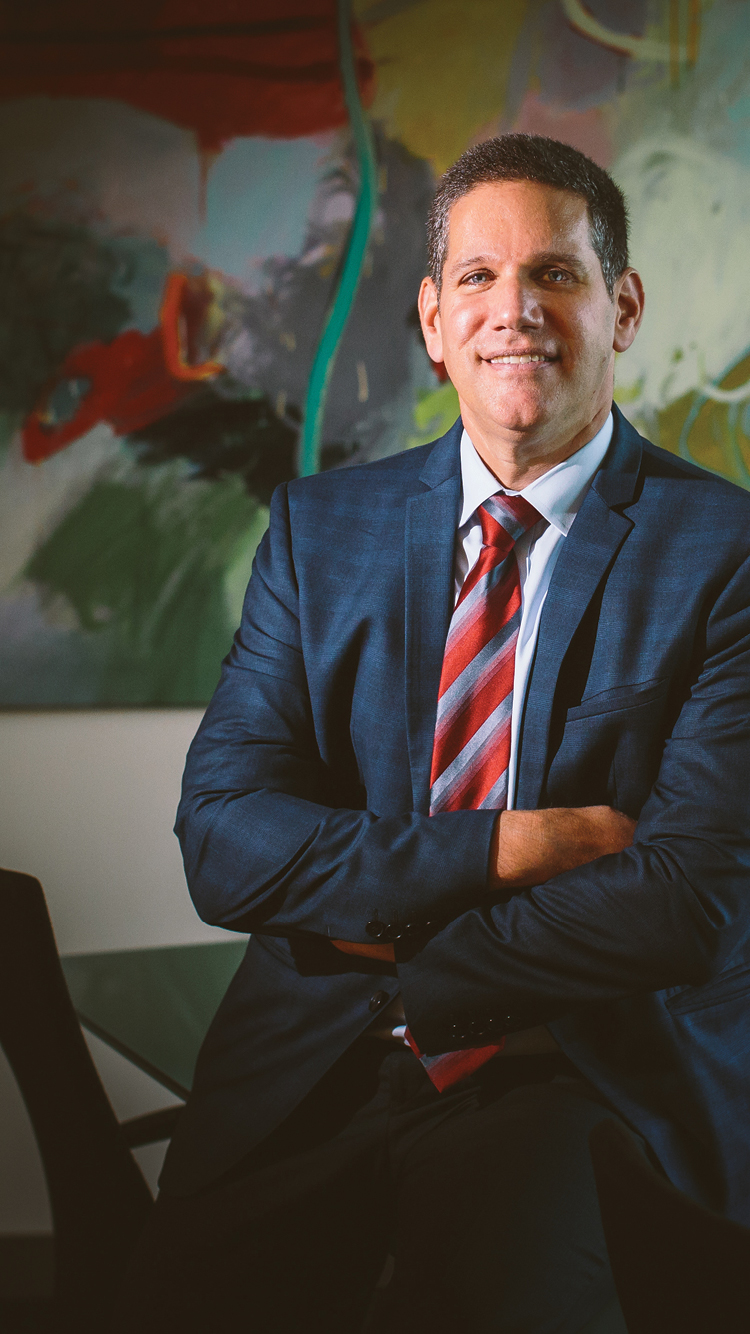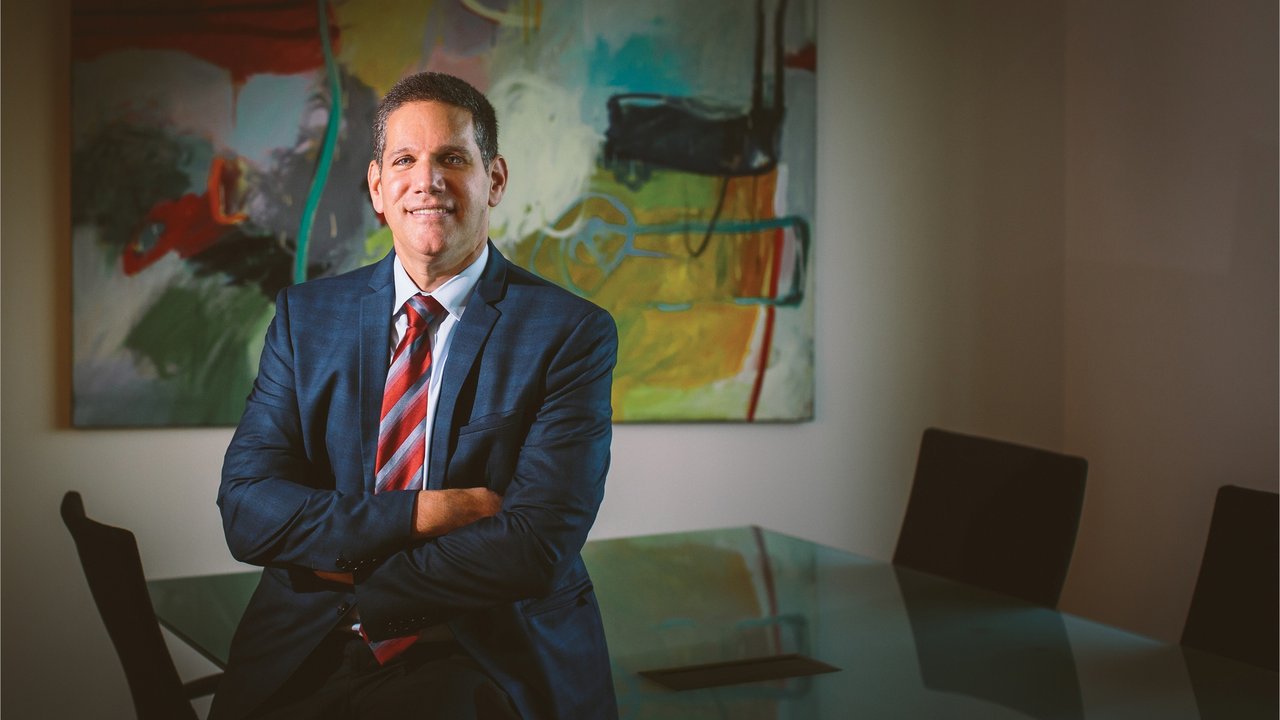IN AUGUST,
AIHA’s Board of Directors appointed Lawrence D. Sloan, CAE, as the association’s new CEO. At the time, Sloan was president and CEO of the Society of Chemical Manufacturers and Affiliates (SOCMA), the leading trade industry serving the specialty chemicals industry. In his six-plus years at SOCMA, Sloan led SOCMA’s efforts to increase public confidence in this industry, champion laws and regulations for SOCMA member companies, and maximize business opportunities.
Shortly after his appointment, Sloan visited the AIHA office for an interview with
The Synergist
. He discussed his background as a chemical engineer, his experiences in nonprofit leadership at SOCMA and the Adhesive and Sealant Council, his familiarity with industrial hygiene, and his goals for AIHA. Sloan will begin work in his new position on October 17. He can be reached at lsloan@aiha.org
.
What motivated you to change careers from chemical engineering to nonprofit management?
My transition from chemical engineering to the business side—the dark side, as my engineering manager used to call it—started well before I switched over to nonprofits. I pursued my MBA in the early 1990s, which led to stints in marketing and ultimately field sales. I was quickly exposed to a broad variety of industries in my sales capacities. It wasn’t until the late 1990s when I realized my job as a field sales rep was too isolating and required too much time behind the windshield that I turned to the nonprofit sector, due in part to my need to remain in the DC area where I had been working for my father. I didn’t want to relocate my family, and started exploring careers that had potential for growth. My old engineering colleague, who had embarked on her career in nonprofit just a few years earlier, suggested looking at a chemical trade association, and that led me to where I am today.
How did you first learn about the industrial hygiene profession?
My exposure to industrial hygiene actually started back when I was an entry-level chemical engineer at a company called Air Products and Chemicals. From my first week on the job, I was put on the road visiting customers. My first project was monitoring an oxygen application at an Ohio brick plant. I befriended a plant operator who had EHS and worker safety responsibilities under his jurisdiction. Because I was basically babysitting a process that left me with a lot of free time between taking my measurements, I followed him around the plant and became introduced to the profession. I became familiar with OSHA, Community Right-to-Know back in the mid-’80s. When I moved on to Nalco Chemical and was assigned to work at their Chicago facility implementing a new barcode inventory management system, I gained further exposure to EHS—keep in mind, this was all before the adoption of OSHA’s Process Safety Management program; however, I learned early the importance of safeguarding worker health as paramount to all else.
What are your top two or three goals for AIHA?
I was exposed to the AIHA strategic plan early on during the interview process, so I have a good appreciation for the challenges and incredible opportunities ahead. As I referenced during my final interview, there
First is growing and sustaining the three LLCs, in particular the Lab Accreditation program, which requires significant investment in time to build new clientele and is faced with an increasing number of competitors.
In terms of membership, we need to further engage with newly minted professionals and get them to join AIHA, but the effort is much more complex than this. We need to work primarily with our key academic partners who have established IH programs and ensure their students get involved in AIHA and continue their involvement once they graduate. While we’re doing all this, we need to be mindful of the more seasoned professionals and ensure that their needs are being met as well.
And, while you only asked for two or three, I can’t end this interview without mentioning the importance of defining and asserting AIHA’s role in the international arena. Our hosting of IOHA in 2018 will be an excellent forum for us to directly influence how the international federation might more effectively operate.
How will you balance the multiple viewpoints found in an individual membership society like AIHA?
Every association is faced with the often competing and conflicting interests of various sub-groups within its membership. This is endemic to associations and a fundamental reason why they exist—to help yield consensus. I will set a tone where we work toward a consensus approach that appeals to at least a “lowest common denominator” philosophy. If an issue is of paramount importance to the industry, then we must invest a concerted effort to uncover the differences of opinion and see how we might forge a harmonized path forward. For issues of lesser importance, it may be more prudent to simply adopt a more passive “monitoring” approach.
What are some of the immediate opportunities and challenges you see facing AIHA and its members in the next three years?
First, we must deal with the challenges of how local sections communicate both with one another and with HQ. We have an opportunity to strengthen exchange of best practices, starting with my personal outreach, coupled with the imminent improvements in our internal IT systems—all designed to improve dialogue.
Next, there is the challenge of meeting the expectations of four generations in the workplace. We need to balance the needs of young professionals starting out with the career enhancement skills desired by more veteran employees. And with respect to reaching out to students, AIHA’s new IH Professional Pathway outreach kit is one way to educate and inspire aspiring professionals in the STEM area about the “everyday heroism” of IH.
Globally, and leading up to IOHA 2018, which we are the proud host of, we must work hard to better understand how we can bring efficiency to the workings of the global federation and exert greater leadership. This event can afford us a terrific opportunity to showcase our ideas.
With respect to the Product Stewardship Society, AIHA has an opportunity to carve out an identity and raise additional revenue if we are collaborative in our approach. I sense there may be opportunities to pick up on training where perhaps other associations have left off.
Finally, the three LLCs present interesting challenges and opportunities. The Registry and PAT programs are leaders in their field—we must ensure they remain financially lucrative. The Lab Accreditation Program, while well recognized, is seeing greater competition. The issue of how it can further differentiate itself and drive bottom-line profit will require much attention.
"Successful government relations departments must build coalitions with other like-minded groups, and prioritize how to allocate often limited resources—you can always throw more money at an issue, but at the end of the day the question is whether the extra expenditure has really bought you something."
How has your work at SOCMA, at the Adhesive and Sealant Council, and as a chemical engineer prepared you for leading AIHA?
Through all of these roles, I’ve been exposed to some of the priorities and needs of EHS professionals in the chemical sector. While I understand AIHA’s membership is much broader than just chemicals, I feel my engineering background will help me quickly get up to speed on understanding some of the more technical elements of the association. In addition, I’ve established a broad network of colleagues both in the chemical sector as well as across the nonprofit community, which I feel will help AIHA foster new partnerships. I’m also very experienced in visiting with members, touring their facilities, speaking on behalf of the association at industry events, and serving as an ambassador, if you will, when cultivating relationships with allied international groups.
How have your previous associations worked collaboratively through alliances to advance their members’ interests?
At SOCMA, much of our alliance building occurs within government relations—we routinely ally with the National Association of Manufacturers on issues that are more “macro” in nature, such as corporate tax reform. With respect to TSCA reform, we were part of a very large coalition led by the American Chemistry Council. Through these coalitions we bring our members’ often unique perspectives to the table to ensure they are being considered—this was particularly important with TSCA reform, where an issue called Confidential Business Information was paramount to ensuring our members’ proprietary chemistries remained safeguarded from foreign companies attempting to steal their intellectual property. At the Adhesive group, we sought out partnerships with nonprofits representing engineers and designers to push the benefits of adhesives over mechanical fasteners in different applications.
What attracted you to the CEO position at AIHA?
AIHA attracted me from the start because there are so many “moving pieces” to get involved in. It’s much more than just a professional society of individuals. There are corporate members. There are three for-profit LLCs, two educational foundations, a product stewardship society, and relationships with allied organizations including sister groups in the U.K. and Australia. So, I was interested not only in AIHA’s core mission to provide education and training, but also to get involved in helping these various elements grow and prosper. I was ready to step up my game and lead a larger, more complex organization after successfully getting SOCMA onto solid financial footing.
SOCMA is a trade association and AIHA is an individual membership association. What are the differences between leading these two types of associations?
I’m keenly aware that an individual membership association may carry unique challenges because you have members representing distinct sectors of the economy—for-profit companies, academia, governmental agencies, and independent consultants. So, on the GR side, I understand there very well may be less federal lobbying around a particular bill, such as TSCA reform, because there may not be sufficient interest across the membership. Even on the federal regulatory side, there may be a less active mode—more monitoring and reporting.
Typically with a trade association you will have more commonality across the corporate members (although in SOCMA’s case we do have both large and small family businesses, so we need to walk a fine line at times). However, the other member-centric functions—education, networking—are similar in my opinion. As for the daily operations—accounting, HR, IT, marketing/PR—I don’t see many differences.
When you became president and CEO of SOCMA in 2010, you succeeded someone who had been with the organization for many years. What did you learn during that transition that will help you as you begin work at AIHA?
Oh, it is always fun to follow a legend. My predecessor at SOCMA, Joe Acker, had come from the industry and was hired as CEO right after he served as board chair. He was CEO for seven years until he stepped down early due to the onset of pancreatic cancer (he passed away the day of my first Annual Dinner, SOCMA’s capstone event—about a year after I took over). Joe was known and revered throughout the industry. However, I knew that the key to earning the board and members’ trust and respect was to get out and shake a lot of hands. I instituted a rather aggressive travel schedule in which I met some two dozen members at their facilities each year. I took opportunities to speak at industry events and became a recognized figure here in DC with our colleagues at EPA, OSHA, and DHS. So, I look forward to establishing a name for myself in the IH community in a similar fashion. I relish the opportunity to attend my very first AIHA event—the Fall Conference during week 2 on the job, which, by the way, is eerily similar to my first week at SOCMA when I had to attend a big trade show and met hundreds of members early on.
Being an effective leader also means taking the time to do a whole lot of listening and ask lots of questions. I continue to practice this at SOCMA, and it really resonates with members when they know their concerns are being listened to.
"AIHA attracted me from the start because there are so many 'moving pieces' to get involved in. It’s much more than just a professional society of individuals."


SOCMA has advocated for several bills that became law, including reauthorization of the Chemical Facility Anti-terrorism Standards and the recently passed TSCA reform. What do you think constitutes a successful government affairs department at an association?
I’m very proud of the multiple legislative victories SOCMA achieved under my watch, including CFATS multi-year reauthorization and, this year, the passage of TSCA reform. SOCMA invested a good deal of resources into the CFATS issue, including having one of its board members testify on the Hill to the importance of multi-year passage so that companies could more effectively plan for the future without worry that the program might be tweaked every year. This member also provided invaluable grassroots support by earning the trust of our friends at the Department of Homeland Security and attending an internal forum in which she was asked to provide input on what wasn’t working well in the law, particularly for small businesses like hers.
A successful government affairs program requires both a top-down and bottom-up approach. First and foremost, the department must earn the trust of key officials serving on those Congressional committees that govern the association’s issues as well as the heads of federal regulatory agencies directly impacting members. From what I understand already about AIHA priorities, my sense is that a significant part of the work will be to monitor and track state-level activity (which SOCMA does less of), because many worker safety issues are affected by individual state laws and regulations. Given this, the association needs to work harmoniously with its local sections. Also, successful government relations departments must build coalitions with other like-minded groups, and prioritize how to allocate often limited resources—you can always throw more money at an issue, but at the end of the day the question is whether the extra expenditure has really bought you something. Often, SOCMA relied on other associations with bigger budgets and more resources to lead the charge, and that’s OK. I would also add that it’s important that members weigh in on proposed amendments to a law or issue—what I have found so rewarding is that their input really can help shape the changes.
Step Up
“I Was Ready to
NEW CEO LARRY SLOAN REFLECTS ON THE CHALLENGES AND OPPORTUNITIES AHEAD FOR AIHA
My Game"
thesynergist | TOC | NEWSWATCH | DEPARTMENTS | COMMUNITY
Photo credit: Ashlee Wilcox / Documentary Associates

See below for video excerpt of Sloan's
Synergist
interview.

